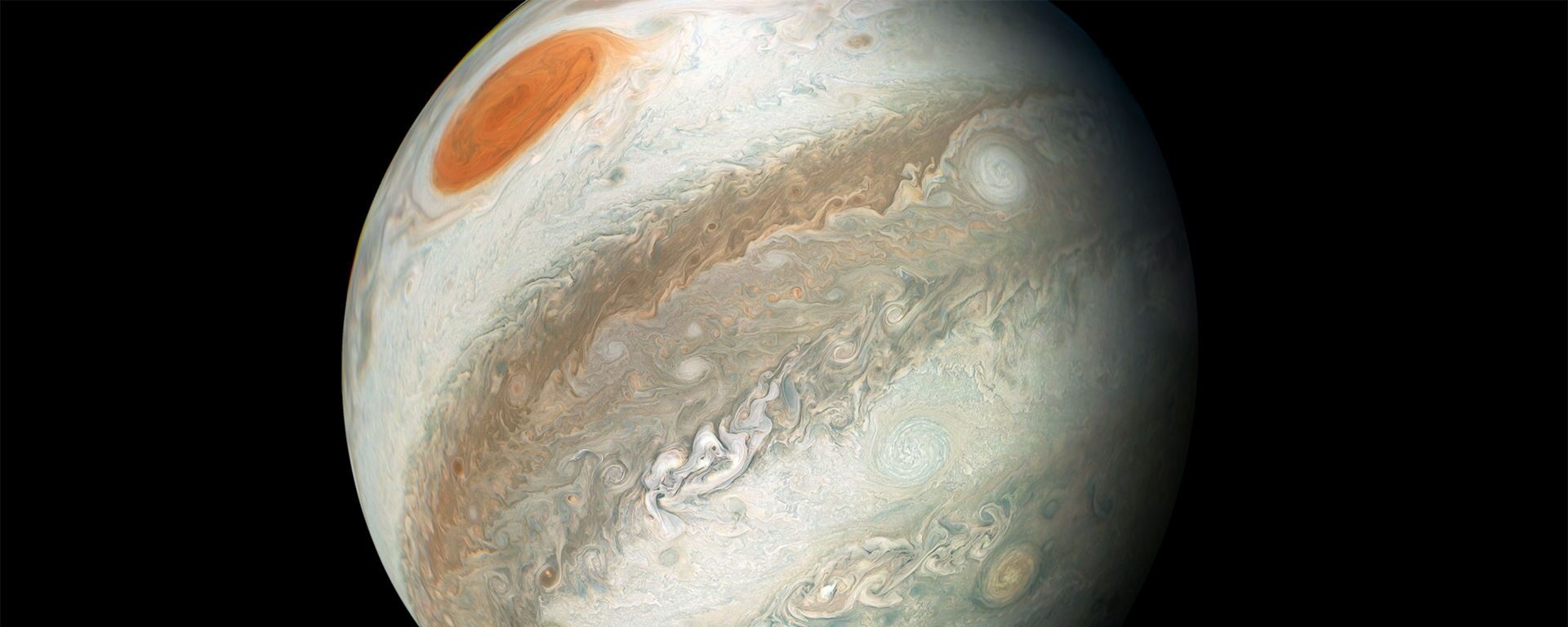https://sputnikglobe.com/20210817/after-decades-long-research-scientists-find-source-of-jupiters-anomalous-heat-1083634961.html
After Decades-Long Research, Scientists Find Source of Jupiter's Anomalous Heat
After Decades-Long Research, Scientists Find Source of Jupiter's Anomalous Heat
Sputnik International
During one of their observations, the team witnessed that Jupiter was experiencing a strong solar flare. Other than the intense aurora, data revealed a wide... 17.08.2021, Sputnik International
2021-08-17T12:36+0000
2021-08-17T12:36+0000
2022-11-03T19:34+0000
newsfeed
world
jupiter
scientists
aurora borealis
milky way
https://cdn1.img.sputnikglobe.com/img/107969/69/1079696965_0:80:1280:800_1920x0_80_0_0_94e6df44ba4ffe7f0cb29872c53b93c8.jpg
A team of scientists has finally found the reason behind the extreme heat, especially in Jupiter's upper atmosphere. After decades of research, scientists have revealed that Jupiter’s version of Earth’s northern and southern lights is the cause of the increased temperature.According to the scientists, the temperature of Jupiter should be about –73°C as it orbits at an average distance of 778 million kilometres from the Sun. However, an area several hundred kilometres above the planet’s cloud tops has an average temperature of about 426°C.Interestingly, scientists first noticed this difference in temperature over 40 years ago. Since then, numerous researchers have come up with various ideas about where the upper atmosphere’s thermal boost might originate from, including pressure waves or gravity waves created by turbulence lower in the atmosphere.The team of scientists led by James O’Donoghue, a planetary scientist at the JAXA Institute of Space and Astronautical Science in Sagamihara, Japan, has provided convincing data that the auroras pump heat throughout the planet’s upper atmosphere.The team used the 10-metre Keck II telescope atop Hawaii’s dormant Mauna Kea volcano to observe Jupiter on one night each in 2016 and 2017. To calculate more precisely, the team looked for infrared emissions that betray the presence of positively charged hydrogen molecules (H3+). While measuring the intensities of these molecules’ infrared emissions, the team was able to detect how hot it gets high above the cloud tops."It was pure luck that we captured this potential heat-shedding event", O’Donoghue said. The team will now be working to understand the underlying mechanisms of heat production and heat transfer in the planet's atmosphere and later incorporate the findings into Jupiter’s atmospheric circulation simulations.
https://sputnikglobe.com/20210609/nasas-juno-spacecraft-captures-first-close-ups-of-jupiters-largest-moon-in-decades-1083105040.html
milky way
Sputnik International
feedback@sputniknews.com
+74956456601
MIA „Rossiya Segodnya“
2021
Sushmita Panda
https://cdn1.img.sputnikglobe.com/img/07e5/05/12/1082926186_0:0:2048:2048_100x100_80_0_0_4474d0d7e27a36878eb8727832be74b4.jpg
Sushmita Panda
https://cdn1.img.sputnikglobe.com/img/07e5/05/12/1082926186_0:0:2048:2048_100x100_80_0_0_4474d0d7e27a36878eb8727832be74b4.jpg
News
en_EN
Sputnik International
feedback@sputniknews.com
+74956456601
MIA „Rossiya Segodnya“
Sputnik International
feedback@sputniknews.com
+74956456601
MIA „Rossiya Segodnya“
Sushmita Panda
https://cdn1.img.sputnikglobe.com/img/07e5/05/12/1082926186_0:0:2048:2048_100x100_80_0_0_4474d0d7e27a36878eb8727832be74b4.jpg
newsfeed, jupiter, scientists, aurora borealis, milky way
newsfeed, jupiter, scientists, aurora borealis, milky way
After Decades-Long Research, Scientists Find Source of Jupiter's Anomalous Heat
12:36 GMT 17.08.2021 (Updated: 19:34 GMT 03.11.2022) During one of their observations, the team witnessed that Jupiter was experiencing a strong solar flare. Other than the intense aurora, data revealed a wide strip of warmer-than-normal gases at mid-latitudes. The researchers interpreted the strip as a wave of warmth rolling southward.
A team of scientists has finally found the reason behind the extreme heat, especially in
Jupiter's upper atmosphere. After decades of research, scientists have revealed that Jupiter’s version of Earth’s northern and southern lights is the cause of the increased temperature.
According to the scientists, the temperature of Jupiter should be about –73°C as it orbits at an average distance of 778 million kilometres from the Sun. However, an area several hundred kilometres above the planet’s cloud tops has an average temperature of about 426°C.
Interestingly, scientists first noticed this difference in temperature over 40 years ago. Since then, numerous researchers have come up with various ideas about where the upper atmosphere’s thermal boost might originate from, including pressure waves or gravity waves created by turbulence lower in the atmosphere.
The team of scientists led by James O’Donoghue, a planetary scientist at the JAXA Institute of Space and Astronautical Science in Sagamihara, Japan, has provided convincing data that the auroras pump heat throughout the planet’s upper
atmosphere.
The team used the 10-metre Keck II telescope atop Hawaii’s dormant Mauna Kea volcano to observe Jupiter on one night each in 2016 and 2017. To calculate more precisely, the team looked for infrared emissions that betray the presence of positively charged hydrogen molecules (H3+). While measuring the intensities of these molecules’ infrared emissions, the team was able to detect how hot it gets high above the cloud tops.
"It was pure luck that we captured this potential heat-shedding event", O’Donoghue said. The team will now be working to understand the underlying mechanisms of heat production and heat transfer in the planet's atmosphere and later incorporate the findings into Jupiter’s atmospheric circulation simulations.




